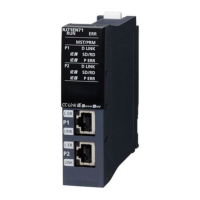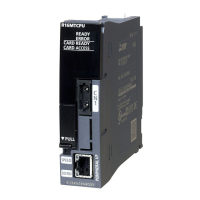5 SYSTEM CONFIGURATION
5.2 Structure of CC-Link IE TSN Class B/A Devices (CC-Link IE TSN Protocol Version 2.0 Only) and Ethernet Devices
83
5
• When connecting a CC-Link IE TSN Class A device in a star topology, connect via an industrial switch (for CC-Link IE TSN
Class B) or an industrial switch (for CC-Link IE TSN Class A).
• When the communication mode setting is multicast, communication may not be possible depending on the device if both a
local station and a CC-Link IE TSN Class A remote station are connected on the end side via an industrial switch. The
communication will be enabled by configuring settings with the industrial switch so that the multicast frame (with multicast
MAC address 09:00:70:00:10:02 and 09:00:70:00:10:05) will not be transferred to the CC-Link IE TSN Class A remote
station port.
Coexistence of line and star topologies
Line and star topologies can be mixed according to the availability of connection as described below.
• When connecting a CC-Link IE TSN Class B device in a star topology, connect with an industrial switch (for CC-Link IE TSN
Class B).
No.0: Master station
No.1, No.2, and No.3: Remote station
Class A: CC-Link IE TSN Class A device
Class B: CC-Link IE TSN Class B device
No.0: Master station
No.1, No.2: Local station
No.3: Remote station
Class A: CC-Link IE TSN Class A device
Class B: CC-Link IE TSN Class B device
No.0: Master station
No.1: Device station
No.2, No.3, No.4, and No.5: Remote station
Class B: CC-Link IE TSN Class B device
No.0
Class B
No.1
Class A
No.2
Class A
No.3
Class A
Industrial switch
(for CC-Link IE TSN Class A)
or
Industrial switch
(for CC-Link IE TSN Class B)
No.0
Class B
No.1
Class B
No.2
Class B
No.3
Class A
Industrial switch
(for CC-Link IE TSN
Class B)
Multicast mode
No.0
No.1
Class B
No.2
Class B
No.4
Class B
No.3
Class B
No.5
Class B
Industrial switch
(for CC-Link IE TSN Class B)

